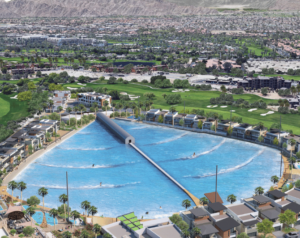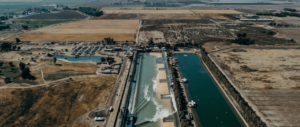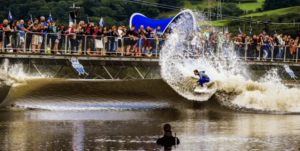Since the beginning, surfing has been inherently tied to the nature of the ocean – riding waves that are unpredictable, shaped by the winds and tides, and different every single day – or even every set. But a new revolution is underway and the game is changing: wave parks. These artificial surf pools are popping up all around the world, offering a hyper-controlled environment where perfect waves can be generated on demand. For some, this is the future of surfing – a way to make the sport more accessible, predictable, and performance-driven. For others, it’s a commercialized mutation that threatens surfing’s soul.
So, are wave parks a revolution, or are they watering down the essence of the sport? Let’s break it down.
The Technology Behind Wave Parks
Wave parks aren’t just oversized swimming pools with choppy waves that you think “Oh yeah I bet I could surf that” like in the wave pool at your childhood waterpark. They’re high-tech engineering feats designed to mimic ocean waves as closely as possible. Several companies have developed their own proprietary technology to create waves of different shapes, sizes, and speeds. Some of the most notable include:
- Kelly Slater’s Surf Ranch – Arguably the most famous of the wave pools, using a hydrofoil system to create long, barreling waves that mimic the best ocean breaks.
- Wavegarden – The self-acclaimed “leader in artificial wave technology” leading wave park developer that has brought surf pools to various locations, utilizing air-powered or hydrofoil-driven technology.
- American Wave Machines – Known for the PerfectSwell technology, offering powerful and customizable waves.
- URBNSURF & The Cove – Pioneers in the modular approach, allowing for waves of different types, from beginner-friendly to pro-level.

These parks can generate consistent waves at the push of a button, something the ocean has never been able to promise. But does predictability come at a cost?
Accessibility: Surfing for the Masses
One of the biggest advantages of wave parks is accessibility. For centuries, surfing has been limited to people who live near the coast. If you’re landlocked, you’re out of luck – or forced to travel long distances to find waves. Wave parks change that equation entirely.
Now, surfers in places like Texas, Switzerland, and even deserts in the Middle East can access perfect waves without ever stepping foot in an ocean. This democratization of surfing means more people can take up the sport, leading to growth in the industry, more diversity in the surf scene, and increased demand for surf gear, coaching, and competitions.
However, this shift also raises questions: If you can surf without ever paddling into an ocean wave, are you still a “real” surfer? And what does this mean for traditional surf destinations and local surf communities?
Progression and Training
Wave parks aren’t just making surfing more accessible – they’re also totally changing the way surfers train. In the ocean, waves are inconsistent, meaning surfers might only get a few really good rides per session. But in a wave pool, every wave is identical, allowing surfers to repeat maneuvers with surgical precision.
For beginners, this means faster learning curves. For professionals, it means the ability to practice high-performance tricks without the variables of ocean conditions. Surfing is now evolving at an incredibly accelerated pace, with aerials and complex combinations becoming more commonplace, thanks to the repetition wave parks provide.
Competitive surfers have already started using wave pools as training grounds. The predictability allows them to refine techniques and dial-in tricks that would be much harder and slower to master in an unpredictable ocean. But is this new form of training giving some an unfair advantage over those who rely solely on natural waves?
Culture vs. Commercialization
Surfing has long been associated with its roots freedom, adventure, and a deep connection to nature. Many surfers see wave parks as a somewhat sterilized version of the real deal – one that strips away the unpredictability, the patience required to wait for the right set, and the raw energy of the ocean.
A lot of people argue that surfing is about much more than just riding a wave; it’s about reading the conditions, connecting with and respecting the ocean, and embracing the lifestyle that comes with the search. Wave parks, by contrast, feel commercialized, essentially a skatepark for surfing – something that’s great for technical progression but lacking the spiritual and cultural elements that make ocean surfing so unique.
Additionally, the presence of artificial wave parks could change the economy of surfing. Will traditional surf destinations like Hawaii, Indonesia, and Australia see fewer visitors as surfers opt for the convenience of wave parks instead? That could be a good one potentially. Or will the industry simply expand, with both natural and artificial waves coexisting?
Environmental and Ethical Considerations
On the surface, wave parks seem like an eco-friendly alternative to traveling thousands of miles to surf. They reduce the environmental impact of surf tourism, which often involves long-haul flights and overcrowding of natural surf spots.
The reality isn’t quite that simple though. Wave parks require enormous amounts of energy and water to operate, raising concerns about sustainability. Some parks use solar energy to offset their carbon footprint, but the overall impact is still significant. Also, wave pools take up large amounts of land, often in areas that require significant infrastructure development.
There’s also the question of ethics: Should we be manufacturing something that has always been a natural phenomenon? Is it right to commercialize surfing to the point where people may never feel the power of an actual ocean wave? Big questions.

The Future of Surfing in a Wave Park Era
With the rise of wave parks, the sport of surfing is at a crossroads of sorts. Some see artificial waves as the future a way to grow the sport, make it more competitive, and even bring it into new Olympic formats. Others worry that it could strip surfing of its essence, fully turning it into just another hyper-commercialized action sport, devoid of its deep-rooted connection to nature.
Will we see professional surf competitions held exclusively in wave pools? Will a new generation of surfers grow up having never surfed an actual ocean wave? Or will wave parks simply serve as an addition to the sport rather than a replacement?
Conclusion
Wave parks are undeniably changing surfing and aren’t going to stop any time soon. They’re making the sport way more accessible, creating new opportunities for progression, and redefining the way surfers train. But they also bring challenges – questions about authenticity, environmental impact, and the commercialization of a once-spiritual pursuit.
At the end of the day, whether you see wave parks as a revolution or a compromise depends on what surfing means to you. Are they an incredible innovation that will push the sport forward, or do they risk turning surfing into something it was never meant to be?
What do you think – are wave parks the future of surfing, or are they just a high-tech gimmick for corporate capture?








